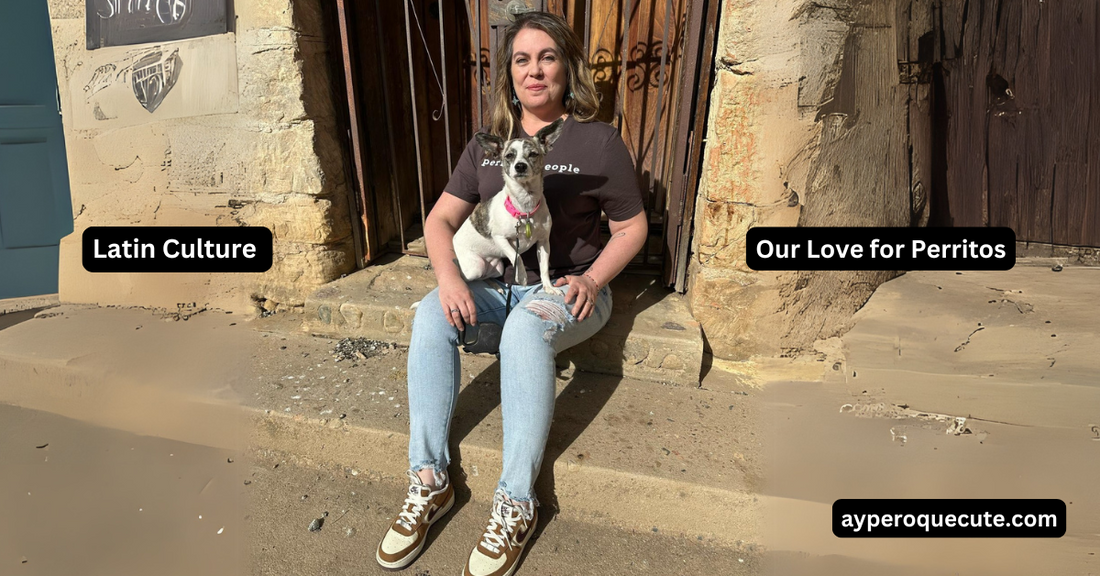
Latin Culture & Our Love for Perritos: A Match Made in Heaven
Share
In Latin America, dogs are more than just pets, they are companions for life, or "compañeros de vida." The deep connection between Latin culture and perritos stems from strong family values, where loyalty, love, and care extend beyond human relationships to include four-legged friends. Unlike in many other parts of the world, where dogs are primarily seen as domestic animals, in Latin American households, perritos are true members of the family.
It is common for dogs to be included in family celebrations, from birthdays to religious events, and even holidays like Christmas and Día de los Muertos. Some families host birthday parties for their pets, complete with treats, decorations, and even small gifts. Others ensure their dogs are part of family portraits and gatherings, treating them with the same affection as any human relative.
This love and admiration for perritos have also become a major influence in fashion and pop culture. From dog-themed accessories to clothing that expresses devotion to furry companions, the Latin American connection to dogs is now reflected in statements like the “Perritos > People” t-shirt, which resonates with proud dog lovers who embrace this special bond.
Read also: Latina Outfits: Style Guide and Outfit Ideas for Every Occasion
The Historical & Cultural Role of Dogs in Latin America
Dogs have been a significant part of Latin American culture for centuries, serving roles beyond companionship. Throughout history, they have been seen as sacred symbols, protectors, hunters, and even guides to the afterlife.
The Role of Dogs in Ancient Civilizations:
-
Aztec & Mayan Influence: The Xoloitzcuintli, or Mexican hairless dog, was considered sacred by Aztec and Mayan civilizations. Believed to have mystical abilities, these dogs were often buried alongside their owners to guide their souls into the afterlife.
-
Inca Societies: In Peru, dogs played a key role in hunting and protection, particularly in rural and mountainous regions where they helped guard livestock.
-
Caribbean & South America: In several Latin American traditions, perritos symbolize loyalty and guidance, often appearing in folklore as faithful protectors of their owners.
Perritos in Modern Latin Culture:
Unlike in the U.S., where dogs are primarily kept as house pets, many Latin American communities embrace street dogs as part of the social fabric. While some may roam freely, they are often cared for by multiple people, forming a unique community-based pet culture where neighbors provide food and shelter to local strays.
Even today, certain Latin American dog breeds hold deep cultural significance. The Xoloitzcuintli remains a national symbol of Mexico, while breeds like the Dogo Argentino are highly regarded for their strength and loyalty.
Perritos as Family: How Latinos Treat Their Dogs Differently?
For many Latinos, perritos are not just animals, they are family. This emotional connection is evident in the way dogs are treated within Latin households, often receiving the same level of love and care as human relatives.
Many Latino pet owners refer to their dogs as "perrihijos" (dog children) or "mi bebé peludo" (my furry baby), reinforcing the idea that these animals are deeply integrated into daily life. Unlike in cultures where pets are expected to stay in their designated spaces, perritos in Latin homes are often included in all aspects of family life.
How Perritos Are Treated in Latin Households:
-
Sleeping Arrangements: Many dogs sleep inside the home, often sharing a bed or couch with their owners, rather than being confined to a kennel or separate room.
-
Home-Cooked Meals: Some Latino families prepare special food for their perritos, ensuring they eat fresh, homemade meals instead of only processed dog food.
-
Inclusion in Family Events: It is common to see perritos present at Christmas celebrations, birthdays, and even quinceañeras, dressed up in festive attire and enjoying the festivities alongside family members.
The Freedom of Latin American Dogs vs. U.S. Pet Culture
Dogs in Latin America and the U.S. live very different lives. While both cultures love their pets, their approach to dog ownership varies greatly.
In Latin America:
-
Many dogs are free to roam during the day and return home at night.
-
They develop a natural awareness of traffic and surroundings, learning how to navigate busy streets.
-
Some families don’t use leashes, they simply let their dogs “walk themselves”, trusting them to explore and return safely.
-
Stray dogs are often cared for by the community, receiving food and attention from multiple people rather than belonging to just one owner.
In the U.S.:
-
Dogs are almost always on a leash when outside or kept in fenced yards for safety.
-
Stray dogs are quickly picked up by animal control and placed in shelters rather than being integrated into the community.
-
There is a strong focus on obedience training and controlled behavior, rather than allowing dogs to socialize naturally.
The Rise of the Latina Dog Mom & Dog-Inspired Fashion
Latina women are redefining what it means to be a proud dog mom, turning their love for perritos into a lifestyle and fashion statement. From social media influencers to everyday pet owners, Latina dog moms are showing off their devotion in unique and stylish ways.
How Latina Dog Moms Show Their Love:
-
Dressing their dogs in stylish outfits: Many dog moms love to coordinate their perrito’s wardrobe with their own, making matching outfits a fun trend.
-
Custom accessories for their furry friends: Engraved collars, personalized harnesses, and fashionable pet carriers are just a few ways Latina women express their love.
-
Statement fashion that celebrates perritos: T-shirts like “Perritos > People” have become a way for dog moms to showcase their bond with their pets proudly.
Perritos are no longer just pets, they are becoming cultural icons in Latina fashion. From casual streetwear to high-end pet couture, the love for dogs is now reflected in clothing, accessories, and even home décor.
Famous Latin American Dog Breeds & Their Cultural Significance
Latin America is home to some of the most unique and historically significant dog breeds in the world. Each breed carries a special cultural meaning, tied to the traditions and history of its country.
-
Xoloitzcuintli (Mexico): An ancient breed sacred to the Aztecs, believed to guide souls to the afterlife and provide spiritual protection.
-
Chihuahua (Mexico): A tiny but fearless dog with a bold personality, deeply connected to Mexican heritage and folklore.
-
Dogo Argentino (Argentina): A powerful and protective breed originally bred for hunting, often seen as a loyal guardian and family protector.
-
Havanese (Cuba): A small, affectionate breed with a playful nature, commonly found as lap dogs in Cuban households.
-
Brazilian Terrier (Brazil): Known for their intelligence and energy, these dogs are excellent for active families and have strong hunting instincts.
Why "Perritos > People" is More Than Just a T-Shirt—It’s a Statement?
Wearing pet-inspired fashion isn’t just about style, it’s a way to celebrate Latin culture and the deep love we have for our perritos. In many Latin American homes, dogs are treated like family, and this connection is something to be proud of. The "Perritos > People" t-shirt captures this sentiment perfectly, turning a shared cultural experience into a bold fashion statement.
What This Tee Represents:
-
Dog Mom & Dog Dad Pride: A way to show the world how much your perrito means to you.
-
A Bold & Relatable Message: Many Latinos would agree that sometimes, perritos really are better than people!
-
A Conversation Starter: This tee sparks discussions about the unique way Latin culture embraces dogs as part of everyday life.
More than just a phrase, “Perritos > People” reflects a way of life. It’s a statement that speaks to the heart of Latin dog lovers, those who know that perritos aren’t just pets; they’re family.
Conclusion
Whether they roam the streets freely or curl up beside us on the couch, perritos are an inseparable part of Latin American culture. They provide love, companionship, and even protection, making them much more than just household pets.
In Latin America, the relationship with dogs is built on tradition, family values, and deep emotional connections. From ancient civilizations that revered them as sacred beings to modern-day pet parents who treat them like their own children, the love for perritos runs deep in our culture.
Celebrating this bond can take many forms, whether through fashion, traditions, or simply giving your furry friend extra belly rubs. However you express your love for perritos, one thing is certain: in Latin America, dogs will always hold a special place in our hearts and our homes.
FAQs
Q. What culture loves dogs the most?
Many cultures around the world deeply love dogs, but Latin American culture stands out for its strong emotional bond with perritos. In countries like Mexico, Argentina, and Brazil, dogs are treated as family members, protectors, and even spiritual guides.
Unlike in some cultures where dogs are seen primarily as working animals or pets, Latin Americans often integrate dogs into daily life, social events, and even religious traditions.
Q. What do dogs represent in Mexican culture?
In Mexican culture, dogs symbolize loyalty, protection, and spiritual guidance. The Xoloitzcuintli, an ancient breed, was considered sacred by the Aztecs and believed to guide souls to the afterlife.
Dogs are also featured in Mexican folklore, art, and even modern celebrations like Día de los Muertos, where they are honored as faithful companions both in life and death.
Q. How do you describe love for a dog?
Love for a dog is unconditional, loyal, and deeply emotional. It’s a bond built on trust, companionship, and mutual care.
Many dog owners describe their love as similar to a parent-child relationship, where they feel responsible for their pet’s happiness, safety, and well-being. This love is expressed through affection, quality time, and a strong emotional connection that lasts a lifetime.
Q. Why is love for a dog so strong?
The love for a dog is strong because dogs offer pure, unconditional companionship. They provide emotional support, loyalty, and non-judgmental affection, which creates a deep connection between humans and their pets.
Scientifically, interactions with dogs release oxytocin (the "love hormone"), strengthening the emotional bond and reinforcing the feeling of love.
Q. How do I express love to my dog?
You can express love to your dog in many ways, including:
-
Physical Affection: Petting, cuddling, and gentle touch help reinforce trust.
-
Spending Quality Time: Playing, walking, and engaging in activities that make your dog happy.
-
Providing a Healthy Lifestyle: Feeding nutritious food, ensuring regular vet visits, and keeping them safe.
-
Verbal Communication: Using a calm, affectionate tone when speaking to them.
-
Respecting Their Needs: Understanding their body language, allowing space when needed, and creating a loving environment.
